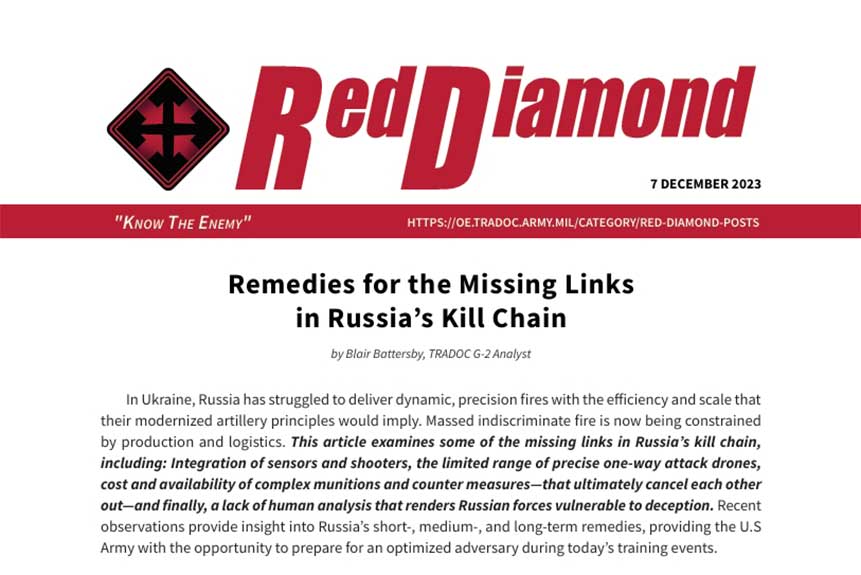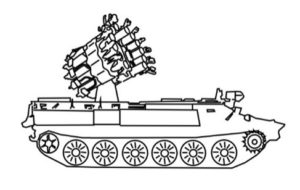
Russia Addressing Missing Links in Kill Chain
by WO2 Blair Battersby, UK LNO to TRADOC G-2
by WO2 Blair Battersby, UK LNO to TRADOC G-2

Vol. 15, No.1 Winter 2024
Observations from the Russia-Ukraine War provide insight into Russia’s remedies to address critical gaps in its kill chain, providing the U.S Army with the opportunity to prepare for an optimized adversary during today’s training events. Russia has struggled to deliver dynamic, precision fires with the efficiency and scale that its modernized artillery principles would suggest. This article examines some of the missing links in Russia’s kill chain, including integration of sensors and shooters, the limited range of precision one-way attack drones, cost and availability of complex munitions and counter measures, and a lack of dynamic near real-time analysis that renders Russian forces vulnerable to deception.
Russia’s reconnaissance fire complex has not achieved complete automation of linked sensors and shooters in Ukraine despite significant modernization efforts. Beginning in 2008, Russia updated its artillery tactics to include dynamic prosecution of high payoff targets using tactical- to strategic-level weapons. Targeting is enabled by Strelets, a network of ruggedized computers that automate the transfer of data between all sensors and shooters. [1] However, complete automation is still difficult in terms of physical connectivity and data compatibility. Operators must manually relay data into and out of the system. Platforms not near Strelets cannot contribute to or rapidly benefit from Strelets’ common operating picture. Although available, Russian units rarely use Strelets in Ukraine due to a lack of trained personnel. [2]
Russia is using new technology to improve sensor-to-shooter links, leveraging the success of Ukrainian techniques. To coordinate artillery, Ukrainian forces use internet connected Android tablets and Kropiva software. The application uses live atmospheric data to provide engagement solutions for numerous munitions and automatically assigns the nearest capable weapon to identified targets, earning it the nickname ‘Uber for Artillery’. [3] Recent reporting details Russia’s addition of commercial wireless technology to systems like Strelets, allowing terminals to interface with multiple connected devices running user-friendly mobile applications. [4] This may fill a crucial gap in Russia’s kill chain, improving multi-echelon, cross-domain fires. Taken a step further, the addition of a low-cost, mass-produced, system-on-a-chip type apparatus to Russia’s full array of sensors could fully automate the output of analog equipment.

Figure 1: How Strelets appears to be evolving, and Ukraine’s Kropiva system.
Russia is focusing on research and development efforts to improve the range and precision of its one-way attack drones. Russia is developing the Lancet ‘Italmas.’ This system is visually similar to the Iranian Shahed-136 and, like the Shahed, it now has an internal combustion engine, increasing the range from 40km to 200km. [5] Technical details are unclear but, like previous Lancets, the ‘Italmas’ is likely to include both coordinates-based and electro-optical targeting. Going forward, Russia could update its stockpiles of “dumb” munitions. The addition of sensors like photodiodes together with an interface to translate target position signals into control surface movement would significantly increase the accuracy of less precise systems.

Figure 2: Russian Lancet and Shahed-136 drones.
Russia is also utilizing legacy equipment in novel ways, a possible indication of low-tech solutions to neutralize expensive Ukrainian countermeasures. Images posted to social media show a Russian MT-LB chassis fitted with an RBU-6000 rocket system. The RBU-6000 is a Soviet-era anti-submarine system normally fitted to maritime platforms. [6] Such a combination is unlikely to improve the range or lethality of existing land systems like the TOS-1 multiple rocket launcher and, in this configuration, the RBU-6000 will be difficult to aim and reload. However, at close ranges it might be effective against Ukrainian forces that breach Russian defenses. It could also be used to elicit enemy force reactions, such as forcing targets to move position. Used at longer ranges, such a system provides low-cost mass munitions to consume expensive countermeasures. Rather than an improvement in capability, such a pairing likely indicates an effort to make the best use of what is at hand.

Figure 3: MTLB chassis fitted with RBU-6000 anti-submarine rocket launcher.
Sophisticated Ukrainian decoys have highlighted how Russia’s lack of human target analysis puts its forces at risk from Ukrainian counterfire. Russian inflatable decoys are cheap, easy to transport, and rapid to deploy; however, slight bulges and wind movement make them easy to identify with high-resolution, near-ground sensors. Ukrainian forces employ detailed replicas of military equipment using wood, foam, and plastic pipe. [7] Ukrainian replicas of high-value targets have successfully deceived Russian artillery, unmasking their location and subjecting them to Ukrainian counterfire. Russia has the ability to conduct reconnaissance, but it rarely applies near real-time analysis. [8] In the near term, this is unlikely to improve, making it difficult for Russia to defeat a deceptive and motivated adversary. Eventually, advances in automation and machine learning might fill this gap, but such a system would likely still be vulnerable to poisoning with false data without data scientists sitting ‘on the loop’.
Implications for U.S. Army Training
- Accurately Represent the Reconnaissance Fire Complex. Representation of a challenging and accurate reconnaissance fire complex during training events might take the form of rapid cross-cueing of ground sensors to unmanned aerial systems. When a high payoff target is identified, fire is immediately requested. Whether or not sensor data is taken at face value is a variable that can be adjusted.
- Integrate Utilization of Mobile Apps. During training events, some opposing forces already use applications like the Android Team Awareness Kit, which uses smartphones and nonmilitary carriers to share data and conduct precision targeting. The effects of security and counterintelligence risks associated with such devices and applications could be rendered by surrogates of military intelligence reporting channels and open-source platforms like the Information Operations Network.
- Continue Integration of Virtual Kinetic Effects of Evolving Capabilities. During field exercises, kinetic effects are often virtual and defined by software because the exercises are constrained by scale, cost, and safety. New adversary weapons (and sensors), including novel remixes and improvements, as well as future technology such as directed energy, can be immediately rendered in the synthetic wrap.
- Conduct Thorough Pre-Exercise Threat Briefs. During exercises, detailed decoys could risk confusion between what is intended to be a decoy and what is intended to emulate the real thing. In some cases, this might be intentional to promote an element of confusion. Otherwise, pre-exercise threat briefs are vital to explain genuine enemy equipment and how it will be represented.
- Maintain Awareness of the Rapidly Changing Operational Environment. Russia is learning from the conflict in Ukraine and making rapid improvements to its equipment and how it is employed. Other combatants in future conflicts will likely do the same. Training is most effective when it not only accounts for how an adversary might employ what something does, but also what it can be made to do.
Related Readings
Blair Battersby, “Russia’s Sensor-to-Shooter Challenges in Ukraine,” TRADOC G-2, (August 11, 2023). https://oe.tradoc.army.mil/2023/07/11/lsco-challenge-russias-sensor-to-shooter-challenges-in-ukraine-intelink-u/ (INTELINK-U/CAC-Card Required).
Kevin Freese, “Smart Phones Playing Prominent Role in Russia-Ukraine War,” Red Diamond Vol. 14, No. 2 (Summer 2023), https://oe.tradoc.army.mil/2023/08/10/smart-phones-playing-prominent-role-in-russia-ukraine-war/.
Karen Kaya, “Turkish-Made Bayraktar TB2 Drones Play Important Role In Ukraine, Foreign Military Studies Office (June 1, 2022), https://fmso.tradoc.army.mil/2022/turkish-made-bayraktar-tb2-drones-play-important-role-in-ukraine/.
Thomas Shrimpton, “People’s Liberation Army Exploring Military Applications Of ChatGPT,” Foreign Military Studies Office (May 1, 2023), https://fmso.tradoc.army.mil/2023/peoples-liberation-army-exploring-military-applications-of-chatgpt/
References
[1] Lester W. Grau and Charles K. Bartles, “The Russian Reconnaissance Fire Complex Comes of Age”, TRADOC G-2 Foreign Military Studies Office (May 10, 2018), https://community.apan.org/cfs-file/__key/docpreview-s/00-00-08-42-86/2018_2D00_05_2D00_01-The-Russian-Reconnaissance-Fire-Complex-Comes-of-Age-_2800_Grau_2D00_Bartles_2900_.pdf
[2] Dr Jack Watling and Nick Reynolds, “Meatgrinder: Russian Tactics in the Second Year of its Invasion of Ukraine”, RUSI (May 19, 2023), hxxps://static.rusi.org/403-SR-Russian-Tactics-web-final.pdf
[3] Charlie Parker, “Uber-style technology helped Ukraine to destroy Russian battalion”, Times (May 14, 2022), hxxps://www.thetimes.co.uk/article/uk-assisted-uber-style-technology-helped-ukraine-to-destroy-russian-battalion-5pxnh6m9p
[4] Dr Jack Watling and Nick Reynolds, “Stormbreak: Fighting Through Russian Defences in Ukraine’s 2023 Offensive”, RUSI (September 4, 2023), hxxps://www.rusi.org/explore-our-research/publications/special-resources/stormbreak-fighting-through-russian-defences-ukraines-2023-offensive
[5] Sofiia Syngaivska, “Russia Has Unveiled a New Kamikaze Drone with a 200 km Range, which Is More Dangerous than the Lancet UAV”, Defense Express (September 22, 2023), hxxps://en.defence-ua.com/weapon_and_tech/russia_has_unveiled_a_new_kamikaze_drone_with_a_200_km_range_which_is_more_dangerous_than_the_lancet_uav-8019.html
[6] Navy Recognition, “Russian Military modifies MT-LB with naval rocket launchers RBU-6000” (September 26, 2023), hxxps://www.navyrecognition.com/index.php/naval-news/naval-news-archive/2023/september/13596-russian-military-modifies-mt-lb-with-naval-rocket-launchers-rbu-6000.html
[7] Emma Graham-Harrison, “A psychological weapon: inside a Ukrainian factory making decoy kit”, Guardian (September 4, 2023), hxxps://www.theguardian.com/world/2023/sep/04/a-psychological-weapon-inside-a-ukrainian-factory-making-decoy-kit
[8] Roger N McDermott and Charles K Bartles “The Russian Military Decision Making-Process & Automated Command and Control”, German Institute for Defence and Strategic Studies (October, 2020), https://www.armyupress.army.mil/Portals/7/Hot-Spots/docs/Russia/GIDSresearch2020_02_McDermott_Bartles%20(2).pdf
Illustrations by the author
DISTRIBUTION A: APPROVED FOR PUBLIC RELEASE; DISTRIBUTION IS UNLIMITED
Distribution A: Approved for public release
Categories:
Tags:
Russia Addressing Missing Links in Kill Chain
by WO2 Blair Battersby, UK LNO to TRADOC G-2
File Size:
565KB
File Type:
Page Count:
5

